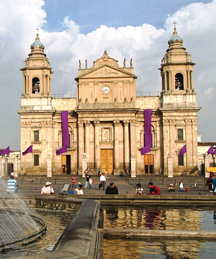
Guatemalan Surprises
First time visitors to Guatemala arrive expecting to be dazzled at every turn. You expect an endless succession of quaint colonial villages, vast expanses of tropical rainforest, haunting Mayan archeological sites, crystalline lakes and mucho mas.
But the first glimpse as you arrive on an early morning flight to Guatemala City may well prove to be the most memorable of all. This capital of one million souls begins its day in a particularly enchanting way. Even though it is perched on a highland plateau some 5,000 feet above sea level, the ever-expanding metropolitan area is dwarfed by the crown-like silhouette of the volcanoes that surround it. With the light of the new day pouring in from the Caribbean and illuminating these living symbols of Guatemala’s prehistoric origins, the spectacle is magical.
For many visitors, though, this might be about all of Central America’s largest city they’ll see. Guatemala City is widely viewed as a “gateway city,” merely a jumping off point. With a little advance planning, tourists can avoid it altogether and from the airport be whisked off to the colonial ambiance of jewel-like Antigua, the exotic indigenous markets and ceremonies of Chichicastenango, Lake Atitlán’s natural splendor, or the imperious Mayan ruins of Tikal. But that would be a mistake, for this vibrant city is full of unexpected surprises and worthy of a visit in-and-of-itself.
Pedro Duchex, the new director of the national tourism institute, is upbeat about the potential of both the nation and its under-appreciated capital. When he sat down with LATINO for an extensive chat, the youthful official led off with a surprising statistic: almost 70 percent of the country’s visitors come from the its closest neighbors---El Salvador, Honduras and southern Mexico. Although European visitors spend more money per day, many tourists from the U.S. do not. “We call them mochileros---backpackers,” he laughs. “Of course, we like backpackers, but the truth is, they don’t spend that much money! So, we have a strategy to create secure areas where they can have a good time and, of course, spend a little more!”
A perfect example of that kind of environment is Guatemala City’s Zona Viva, a trendy district that Mexican hotel executive Ignacio Gomez says reminds him of Mexico City’s famed Zona Rosa. It’s the obvious choice for most visitors, for within a few square blocks one can find most of the city’s finest hotels, a wide assortment of highly rated restaurants, dozens of boutiques and gift shops, and nightclubs featuring live salsa and other styles of music. Because of the favorable exchange rate, top flight hotels, such as the five-star InterContinental, noted for its hospitality and one of the most stunningly beautiful lobbies in all of the Americas, are more than affordable. A half a block away, Los Ranchos, set in a colonial era mansion, is but one example of the exceptional dining experiences that are literally just around the corner. And Los Añejos, in the same neighborhood, offers a quiet and elegant setting to enjoy one of the world›s best rums, Ron Zacapa.
High on the must-do list for any visitor to Guatemala City should be spending some time at the new Museo Ixchel del Traje Indigena, the museum of indigenous clothing---literally a tapestry of the country’s history told through the centuries in the electric colors and thematically detailed textiles of Guatemala’s many native peoples. Truly one of the hemisphere’s most unique museums, the Museo Ixchel should not be missed.
Next, visit the city’s expansive Mercado Central, a carnival of color and entrepreneurial tradition where the multi-ethnic faces, food and fashion of Guatemala come to life. A mere block away in the city’s historic center is one of the largest public squares in the Western Hemisphere. Of particular interest is the grandiose, green-colored former presidential palace, today known as the National Palace of Culture. It’s a monument to the regal splendor of post-colonial Spanish architecture that is reflected in many of the city’s finest edifices. And that’s just a starting point...there’s much more to discover in Guatemala City.
By Mark Holston
